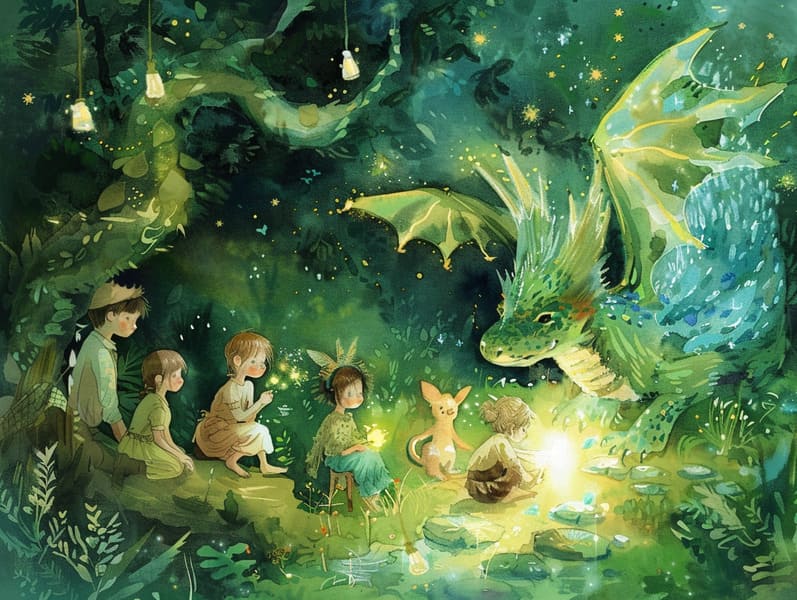The Story Behind Old Fairy Tales and Their Unwavering Appeal.
The Story Behind Old Fairy Tales and Their Unwavering Appeal.
Blog Article

Fairy tales have deep roots. These tales have been transmitted from one generation to the next centuries before they were ever transcribed. They originated from a variety of backgrounds, including Western traditions. They were initially told among older generations, often carrying themes and messages mirroring the societal norms and beliefs of the time.
The renowned Brothers Grimm, Jacob and Wilhelm Grimm, were among the first to collect and release many of these beloved fairy tales. Their collection, "Grimm's Fairy Tales," included classics like "Cinder Maid," "Hansel and Gretel," and "Little Snow White," which have since become mainstays in the world of timeless fairy tales. Similarly, H. C. Andersen's fanciful tales, such as "The Mermaid's Tale," and "The Little Duckling," have stolen hearts worldwide, cementing their place in the pantheon of famous fairy tales.
Despite being ancient, these stories remain as pertinent as ever, especially as kids' bedtime tales. These magical stories are now available in various formats, including vibrantly illustrated books, fantastical animations, and internet fairy tales.
Their enduring popularity can be connected to several magical reasons:
Life Lessons: Traditional fairy tales often convey important moral lessons. Fairy tales like "The Tale of the Boy Who Cried Wolf" teach the virtue of being truthful, while "The Tortoise and the Hare" exemplify the qualities of persistence and unpretentiousness. These stories offer young readers clear distinctions between truth and falsehood, guiding their moral compass in a subtle yet meaningful way.
Sympathy and Perception: Old fairy tales frequently present personalities facing problems and hurdles, fostering young readers to feel with their struggles and celebrate their triumphs. For instance, "The Story of Beauty and the Beast" shows us the merit of appreciating inner worth to recognize the true character of a individual, nurturing kindness and understanding.
Cultural Understanding: Many ancient fairy tales are deeply ingrained in the cultural contexts from which they grew. Reading these tales can provide fascinating glimpses into different historical contexts, developing a sense of cultural awareness and discernment.
Imagination and Creativity: The fantasy-filled elements in fairy tales—magical kingdoms—activate children’s visions. These stories carry readers to magical realms, motivating imaginative dreams and a sense of delight that continues a lifetime.
Timeless fairy tales are not only spellbinding but also instructive. They serve as enchanted tools in strengthening various intellectual and emotional capacities in children. When classic fairy tales are voiced, they foster verbal development by offering new phrases and detailed sentence structures. This practice also promotes hearing abilities and mental focus, as young readers pay close attention, expectant to see what happens next.
Furthermore, exploring the themes and characters of fairy tales can nurture reasoning skills and problem-solving abilities. Young readers are guided to see patterns, predict happenings, and grasp cause and effect. These contemplations also encourage young readers utter their thoughts and feelings, boosting their emotional intelligence.
In today’s digital age, the prevalence of online fairy tales has made these stories more acquirable than ever. Web-based platforms and digital apps share vast collections of classic fairy tales that can be perused or played anytime, anywhere. Fairy tales read aloud are particularly favored, supplying an immersive method for children to engage with these fantastical tales. Sound books and spoken videos lead characters and settings to life, often complemented by magical musical scores and tunes that intensify the tale-telling adventure.
The timeless fascination of ancient fairy tales lies in their ability to modify to new eras while keeping hold of their fundamental ideas. Contemporary reimaginings of these tales often show more representative figures and modern settings, making them pertinent to today’s audience. However, the basic principles of boldness, compassion, and rightness remain unchanged, continuing to affect young readers of all ages.
Timeless fairy tales also offer a sense of coziness and understanding. They present a ordered narrative with a recognizable beginning, middle, and end, often ending with the finalization of conflicts and the triumph of virtue over vice. This regularity can be comforting for young ones, imparting a sense of consistency in an inconstant world.
Classic fairy tales continue to delight and inform new generations, maintaining their magic and relevance in modern society. As children's bedtime stories, they render a perfect blend of wonder and wisdom, supporting moral values, empathy, and creativity. The existence of web-based fairy tales and the popularity of fairy tales read aloud warrant that these traditional narratives remain attainable to new generations.
By preserving and circulating these narratives, we continue to pay tribute to the rich tapestry of fantasy and cultural heritage. Whether you are perusing a beautifully illustrated book, experiencing a electronic collection, or hearing an sound book, the captivation of traditional fairy tales is always within reach. These tales remind us of the persistent spell of tales and its ability to hold us together get more info across generations and cultures.
Whether you are experiencing a colorful picture book, discovering a digital library, or listening via an sound book, the magic of old fairy tales is always within reach.
These tales point out of the timeless force of stories and its ability to connect us across time and space, creating a bond that captivates and teaches alike.